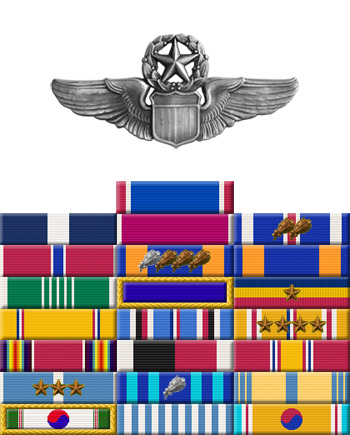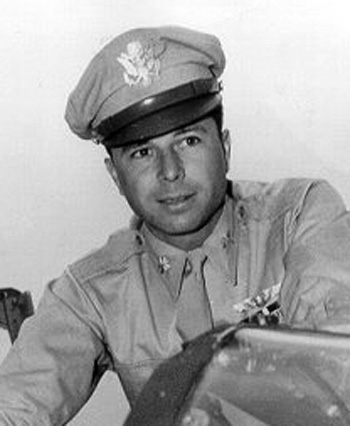
|
John W. Mitchell |
 |
|||
| Rank, Service | ||||
Colonel O-6, U.S. Air Force |
||||
| Veteran of: | ||||
|
||||
| Tribute: | ||||
John Mitchell was born on July 14, 1915, in Enid, Mississippi. He attended Columbia University in New York City from 1931 to 1934, and then enlisted in the U.S. Army on April 9, 1934. He completed basic training at Fort Slocum, New York, in May 1934, and then served with Battery F, 55th Coast Artillery Corps at Fort Ruger on Oahu, Hawaii, from July 1934 until his honorable discharge from the Army on September 8, 1938. Mitchell next attended the University of Georgia for a semester in 1939, and then enlisted in the Aviation Cadet Program of the U.S. Army Air Corps on November 10, 1939. He attended Primary Flying Training at Love Field in Dallas, Texas, from November 1939 to February 1940; Basic Flying Training at Randolph Field, Texas, from February to May 1940, and Advanced Flying Training at Kelly Field, Texas, where he was awarded his pilot wings and commissioned a 2d Lt in the U.S. Army Air Corps on July 26, 1940. His first assignment was as a P-40 Warhawk pilot and Flight Leader with the 55th Pursuit Squadron of the 20th Pursuit Group at Moffett Field and then Hamilton Field, California, from August 1940 to January 1942, and during this time he deployed to England as a Military Observer from May to July 1941. He flew Supermarine Spitfires and Hawker Hurricanes while in England. Capt Mitchell's next assignment was as a P-39 Airacobra pilot, Flight Leader, and Operations Officer with the 70th Fighter Squadron, U.S. Army Forces Fiji, on Fiji from January to September 1942, followed by service as a P-39 pilot, Flight Leader, and Operations officer with the 67th Fighter Squadron of the 347th Fighter Group at Henderson Field, Guadalcanal, from September to November 1942. During this time, Capt Mitchell was credited with his first 3 aerial victory credits, all while flying the P-39. He transferred to the 339th Fighter Squadron of the 347th Fighter Group at Guadalcanal in November 1942; serving as a P-39 and then P-38 Lightning pilot and Commander of the 339th from November 1942 to May 1943, and during this time he was credited with another 5 aerial victories, all while flying the P-38. Also during this time, Major Mitchell commanded Operation Vengeance, the mission to shoot down the airplane carrying Admiral Isoroku Yamamoto, on April 18, 1943, for which he would be awarded the Navy Cross. He served a tour with Headquarters Army Air Forces as a Tactical Inspector from June to October 1943, and then with IV Fighter Command in San Francisco, California, from October to December 1943. His next assignment was as Commanding Officer, Executive Officer, Air Inspector, and Deputy Commanding Officer of the 412th Fighter Group at Muroc, California, at Palmdale Army Air Field, California, and then at Bakersfield Municipal Airport, California, from December 1943 to April 1945. Lt Col Mitchell served as a P-51 Mustang pilot and as Deputy Commander of the 15th Fighter Group at South Field, Iwo Jima, from May to June 1945, and during this time he was credited with his final 3 aerial victories of World War II, all while flying the P-51, giving him a total of 11 air victories in World War II. Col Mitchell was briefly assigned as Deputy Commander of the 21st Fighter Group on Iwo Jima during July 1945, and then as Commander of the 15th Fighter Group on Iwo Jima from July to October 1945. He was assigned to Randolph Field, Texas, and Williams Field, Arizona, for leave and pending reassignment from October 1945 to February 1946, and he then served as Assistant Director of Training and Operations, Director of Training and Operations, and then as Assistant Commandant at Keesler Field, Mississippi, from February 1946 to August 1947. Col Mitchell attended Air Command and Staff School at Maxwell AFB, Alabama, from August 1947 to June 1948, and then served as Air Base Commander at Godman AFB, Kentucky, from June 1948 to June 1949. His next assignment was as an Instructor and F-51 pilot for the 63rd Fighter Wing of the Texas Air National Guard at Ellington Field, Texas, from July 1949 to November 1950, followed by service as an F-80 Shooting Star and then F-94 Starfire pilot and Commander of the 57th Fighter Interceptor Group at Elmendorf AFB, Alaska, from November 1950 to November 1951. Col Mitchell served as Air Inspector with the 39th Air Defense Wing at Elmendorf AFB from November 1951 to June 1952, and then as an F-86 Sabre pilot and Commander of the 51st Fighter-Interceptor Wing in South Korea from June 1952 to May 1953. During this time he was credited with the destruction of another 4 enemy aircraft in aerial combat during the Korean War, for a two-war total of 15 destroyed in the air. His next assignment was as Deputy for Operations with Headquarters 28th Air Division at Hamilton AFB, California, from June 1953 to July 1955, followed by service as Vice Commander of the 28th Air Division at Hamilton AFB from July 1955 to July 1956. Col Mitchell attended the National War College in Washington, D.C., from July 1956 to July 1957, and then served as Commander of the Detroit Air Defense Sector with Air Defense Command at Custer Air Force Station, Michigan, from July 1957 until his retirement from the Air Force on August 1, 1958. John Mitchell Flew West on November 15, 1995, and was buried at Golden Gate National Cemetery in San Bruno, California. |
||||
|
||||

